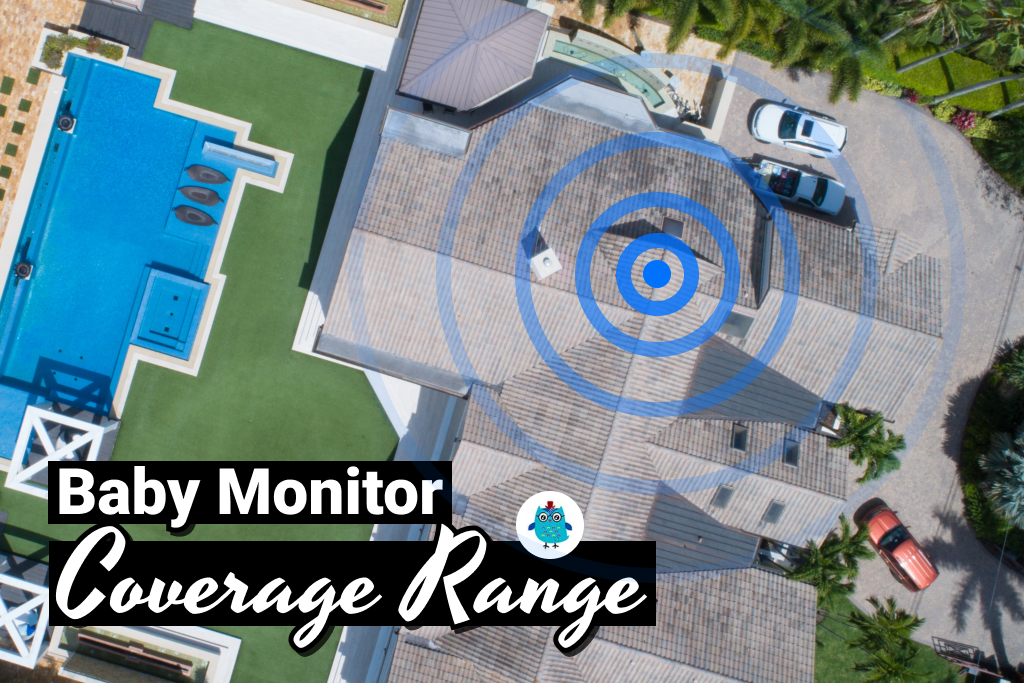Explore the best long range baby monitors. Learn about long distance range and how to get 2,000 ft coverage without WiFi and unlimited range with WIFI.
Listen, as a dad of two, I get it. The thought of being out of range when my baby needs my help makes my heart race. I know firsthand the anxiety of leaving your child alone in their room while enjoying a much-deserved Netflix time. That’s where long range baby monitors come into play.
Long range baby monitors can free you from the confines of your little one’s nursery area. Offering the liberty to move anywhere in your home or yard. Whether it’s 2,000 ft or 10,000 ft away, these monitors ensure that distance is no longer a barrier to your peace of mind.
Now, you might be thinking, “What about WiFi?”. Great point. Models like my favorite, the Nanit baby monitor , work wherever WiFi is available. However, some parents don’t want to rely on WIFI, so there is some long range baby monitor without WIFI too.
, work wherever WiFi is available. However, some parents don’t want to rely on WIFI, so there is some long range baby monitor without WIFI too.
In the coming sections, we’ll dive deep into why the long range is essential, the actual distance the ‘long range’ covers, and how to determine your range needs.
This article will cover the following:
- Best Long Range Baby Monitors
- Type of Baby Monitor With the Best Range
- Why Distance Range is Important
- The Longest Range for Baby Monitors
- Determining Your Needs
- How Monitors Signals Works
- Baby’s Safety
- Conclusion
Let’s start by looking at the best baby monitors that cover long distances.
If you’re seeking for the best baby monitor and hoping to find real reviews from real parents. You should check out this list I created of the top baby monitors.
🤗 Transparency Statement: This page may contain affiliate links. If you make a purchase through these links, I may earn a commission at no extra cost to you. Rest assured, I only promote products I trust. Thanks for your support!
What Are the Best Long Range Baby Monitors?
When I first bought a baby monitor, I only considered the size of my home as a reference to the range I needed to cover. So I figure that most baby monitors would work. What a mistake!
After trying different baby monitors, I have understood the range stated by the manufacturer is always in an open field and not indoors.
Here are the monitors who actually work!
| Baby monitor | Types | Transmission | Range | Price | More details |
|---|---|---|---|---|---|
| Nanit | Video | WIFI | Unlimited | $$$$$ | Check price on Amazon |
| Philips Avent DECT | Audio | DECT | 900 ft | $$$$$ | Check price on Amazon |
| Babysense | Video | 2.4 Ggz | 900 ft | $$$$$ | Check price on Amazon |
| VTech VM321 | Video | DECT 6.0 | 1000 ft | $$$$$ | Check price on Amazon |
| Vtech DM221 | Audio | DECT 6.0 | 1000 ft | $$$$$ | Check price on Amazon |
| VTech VM923 | Video | 2.4 Ggz FHSS | 1000 ft | $$$$$ | Check price on Amazon |
The best long range baby monitor is the Nanit , because the WiFi connection offers unlimited range. But, many other baby monitors can cover up to 2,000 feet. Read the following review because the longest range you can cover with a baby monitor is never what the manufacturer tells you.
, because the WiFi connection offers unlimited range. But, many other baby monitors can cover up to 2,000 feet. Read the following review because the longest range you can cover with a baby monitor is never what the manufacturer tells you.
For more information on the Nanit, check out my full review of this baby monitor here.
What Type of Baby Monitor Has the Best Range?
It will undoubtedly depend on the type of monitor you choose; you can expect to have more or less coverage. The audio monitor always has the best range. But ultimately, it will come down to the monitor quality you get.
#1 – WiFi Baby Monitor Win the Range Distance Battle
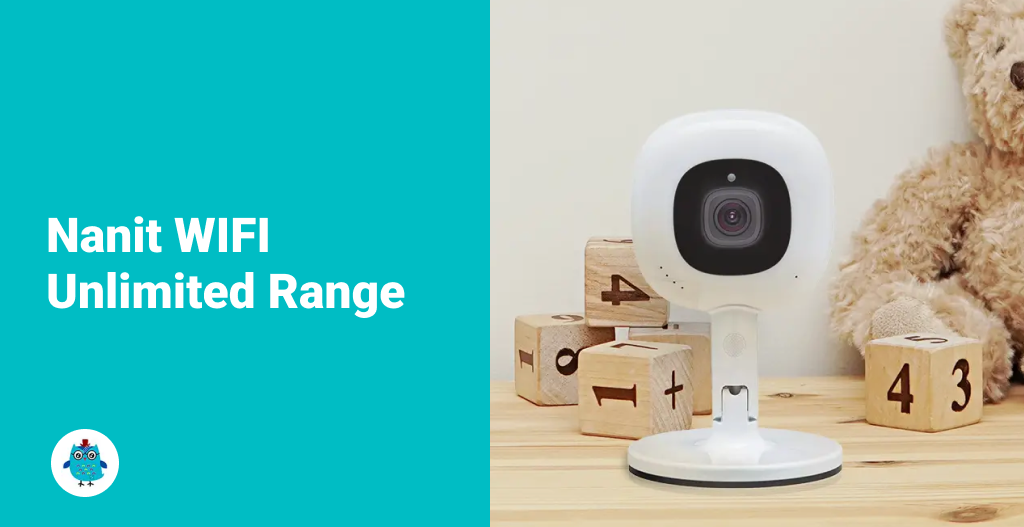
My recommendation: Nanit WIFI Baby Monitor
With an internet connection, you can access your WIFI baby monitor feed from anywhere in the world. With this being said, I would not go out of town for the night because my baby monitor could still be working 50 miles from my house. I still need to be able to respond quickly if my baby cries out for my help.
- Advantage Of WiFi Monitor: With any WiFi baby monitor, the range will depend on the force of your signal. As long as you have a fast and robust WIFI connection, broadcasting videos image from the baby monitor will never be a big concern for you.
- Downside With WiFi Video Monitors: But you must take into consideration the up and down of your internet connection. An unstable connexion will crush the advantage of watching your baby from almost anywhere. Because the internet connexion loss will bring down the transmission with him.
For more information on WIFI monitors, check out this article I did about WIFI vs. non-WIFI baby monitors.
#2 – Audio Monitor Is Second Best
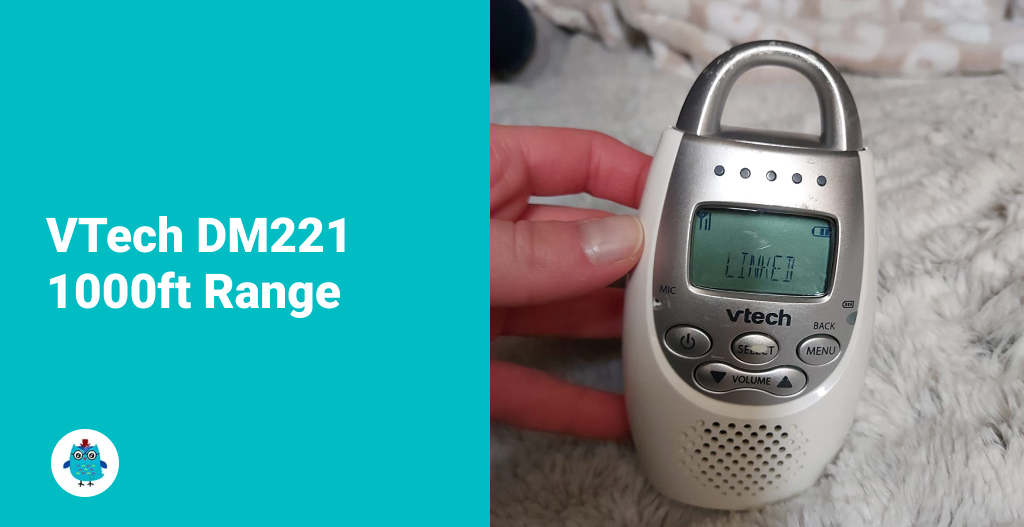
My recommendation: VTech DM221
In most situations, audio baby monitors will have a more extended range than baby monitors with cameras. You don’t have to be worried about internet or Bluetooth connexion loss. No frozen video stream, giving you the impression your baby has been sleeping in the same position for the last 2 hours. Plus, most audio monitors will alert you if you go out of range.
But keep in mind the quality of the audio monitor range can be affected by factors such as the thickness of the wall, any obstructions, electric wiring, electric devices, and the distance to be covered.
For more information on audio monitors, check out this article about why audio baby monitors are still king.
#3 – Long Range Walkie-Talkie Cab Be An Excellent Option Too
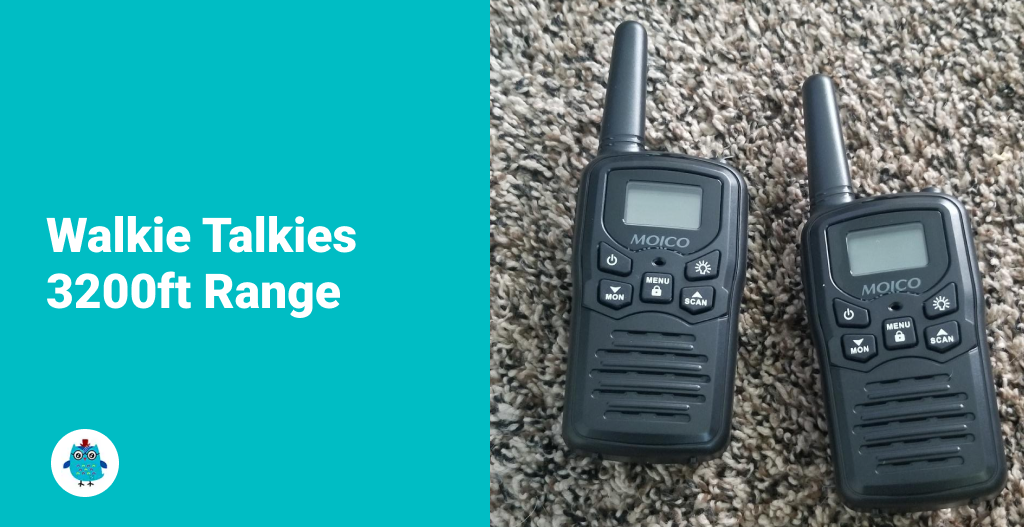
My Recommendation: MOICO Long Range Walkie-Talkie
Suppose you travel on vacation with your kids. In that case, you may want to eat at the hotel restaurant after bedtime. At the same time, you want the peace of mind that goes with being sure you will hear them if they are not sleeping, playing around, or crying.
Some walkie-talkie radios have a special baby listener mode. This means that you can use it as a baby monitor system. Except that those walkie-talkies work much better than the actual baby monitor. Most baby monitors have a short range.
You can leave one radio in the hotel room using a walkie-talkie with the baby monitor mode. So you can appreciate an evening meal or drink a couple of doors away and still be capable of listening to what’s going on with your kids.
Some radios have enough range to work through several hotel floors and beyond.
#4 – Video Monitors (Almost All) Have The Worst Range
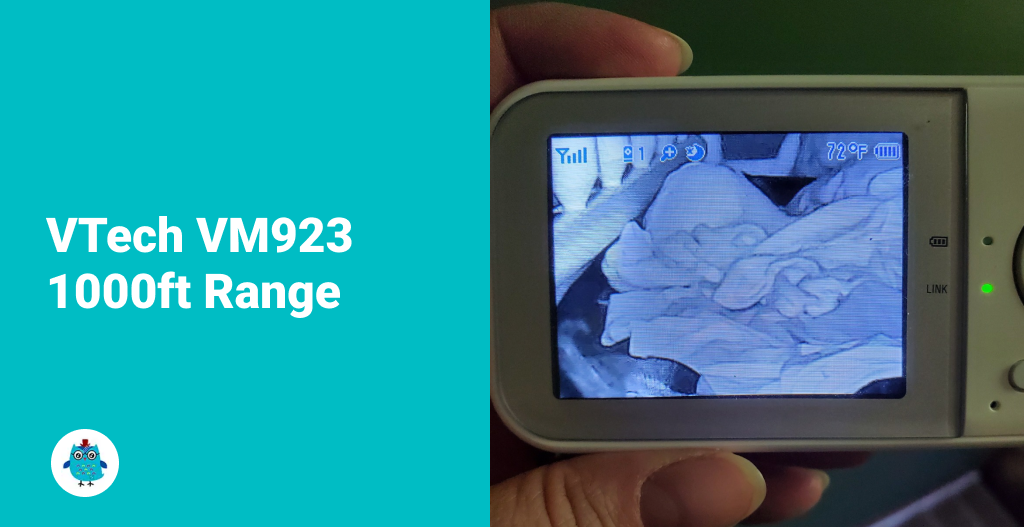
My Recommendation: VTech VM923
No matter if you buy a high-definition video camera. If you go too far away with your baby monitor, the image is the first thing you will lose if you go out of range.
A short-range monitor will not be capable of transmitting the best images and sounds.
But if you decide to go for a long range video baby monitor, I recommend the VTech VM923 . Two of my friends use it without reporting any issues and live in large houses.
. Two of my friends use it without reporting any issues and live in large houses.
Is the Bluetooth Range of My Monitor Enough?
Some monitor brands are using the newest Bluetooth LE technology. Porsche and BMW used the same technology. These monitors have top-notch coverage for a house of 2,000/3,000 square feet. They also claim to cover homes up to 5,000 square feet.
Always Keep the Recipe and Test Your Monitor
I want to be 100% sure of your baby monitor capacity regarding the range. This information will give you a clear idea of how far away you could go.
Don’t just trust the baby monitor manufacturer’s listed range.
I always prefer to test the monitor inside the location I will be using it. But this can’t be performed whenever I’m invited to sleep over.
You want to find out: How many walls are between you and your baby unit? And how far before the monitor went out of range? Remember that sometimes there is an alarm or a notification, but the screen just froze other times.
Why Should You Care About Your Baby Monitor Range?
You should always care about the range when purchasing a baby monitor. You will want a baby monitor that will reach all corners of your entire home. The coverable distance needs to go as far as you will be from your kid’s room without altering the clarity of the signal.
Their superior range ensures we’re connected to our little ones, even when life pulls us in a million different directions. However, buying the most expensive model of baby monitor is not guaranteed to perform well in your house.
Here are some real-life scenarios that show why these bad boys are a godsend in modern parenting.
In What Scenarios a Long Range Monitor Can Be Helpful
- Large Homes and Open Spaces: Whether you live in a multi-level house or have a backyard the size of a football field, a standard monitor’s range might not cut it. Picture this: you’re flipping burgers at the far end of the garden, and your standard monitor starts to fizzle out, turning your BBQ into a stress fest. With a long range monitor, you can rest easy knowing you’re still connected.
- Juggling Act: As a parent, you’re expected to multitask like a seasoned circus juggler. Between the dishes, laundry, and that DIY project that’s been on hold since 2020, you’ll find yourself all over the house. A long range monitor ensures you can tick off that to-do list without sacrificing your baby’s safety.
- Guests, Gatherings, and Good Times: Hosting a family dinner or a game night with friends? A long range monitor will give you the flexibility to socialize and be the host with the most, all while ensuring the little one sleeps soundly upstairs.
- Work from Home: Balancing work calls and nap times can be tricky for those working from home. With a long range monitor, you can set up your home office anywhere and keep an ear out for your baby’s needs.
- Self-care and Sanity: From a quick shower to a workout session or even just enjoying a hot cup of coffee in peace—these small moments of self-care are crucial. A long range monitor gives you the freedom to take care of yourself, knowing your baby is safe.
As a dad of two often found in the garage or the garden, I can’t stress enough how essential a long range monitor has been.
How Long Distance Monitors Alleviate Concerns (Understanding Your Fears)
- Uninterrupted Connection: The primary fear we all have is losing the signal at a crucial moment, right? With a long range baby monitor, you get an uninterrupted connection to your baby’s room. Whether working in the garage or trying to beat your high score in the gaming room, you can be sure you’re still in touch.
- Peace of Mind: At the end of the day, a long-range monitor’s most significant benefit is its peace of mind. A study from the Journal of Pediatric Health Care
 confirms that the use of baby monitors does, in fact, reduce anxiety in parents and improve sleep. So we’re not just talking about theoretical benefits here. This is real, data-backed peace of mind.
confirms that the use of baby monitors does, in fact, reduce anxiety in parents and improve sleep. So we’re not just talking about theoretical benefits here. This is real, data-backed peace of mind. - More Freedom: Moving around the house freely without losing the signal lets you manage other responsibilities or enjoy a bit of leisure time. As one parent to another, having that freedom while knowing your baby is safe is priceless.
Remember that it’s not just about buying more gadgets. It’s about equipping ourselves with the right tools to navigate the wild ride of parenthood. Now, are you curious about the actual distance these monitors can cover?
What is the Longest Range for Baby Monitors?
A good range for a standard baby monitor is generally around 600 to 1,000 feet. But some baby monitor claim to cover an open field up to 5,000 feet.
This coverage should be enough for indoor usage inside a small apartment. So, if you live in an apartment and are not planning on sitting in the garden while your baby is napping, the standard 600 to 1,000 feet will be enough.
If you live in a house with a large yard, a good range should be above 1,000 feet. I suggest 2,000 feet. Walking in your backyard without losing the signal would be best.
Since the range can be a deal breaker, most brands advertise a range for their monitor. A so-called “open field” range.
What Does Open Field Range Mean?
The open field range means the gap between your baby unit and your monitor ends, specifically with no obstructions. Imagine a flat empty football field. The test to get the maximum distance is done without obstacles between the transmitter and the parent unit.
In my opinion, the open field range stipulations are very misleading for parents.
Because you will never use your baby monitor in an open field. Who cares for a monitor that can transmit across 3,000 feet of an open area? Your baby will never be napping in an open field.
You’ll use it inside your house with many walls and obstacles between you and your baby.
This means that the actual range you will cover is inside your home. And that will be very different from what the manufacturers told you.
I wouldn’t blindly trust the manufacturer’s range of distances.
Why is Indoor Range More Critical?
Remember that the monitor coverage in the manual is not what you will get inside your home. The range will be around 20 times less than the so-called open field range.
Each house is always different because of the walls, doors, electronic devices, and wiring. Which will all present unique barriers that conflict with the monitor signal.
Plus, each monitor brand and type is different. Some will be much better at receiving a clear signal even through multiple walls.
Also, each household is unique, and what works perfectly for my suburban two-story might not be the best for your downtown loft. The key is understanding your needs and the layout of your space.
From my personal experience, having a monitor that reaches the corners of my yard has made summer BBQs far more enjoyable and relaxing. I can keep an eye (and ear) on my youngest’s naptime while still being part of the action.
Now that we’ve established the impressive reach of long range monitors, let’s move on to figuring out how to determine the range you actually need.
Determining Your Long Range Needs
Getting caught up in the numbers game is easy, but let’s take a step back. The crucial thing is to figure out what your unique needs are. I’ll help you figure out what range you need based on your home layout, lifestyle, and those peculiar places you find yourself when the baby decides to nap.
How Big is Your House?
- Large Homes: If you’re living in a spacious suburban house, the nursery feels like it’s a mile away when you’re in the living room. A long range monitor with an extensive indoor reach is your best bet. Remember, walls and appliances can interfere with the signal, so having more range than you think you need is better.
- Multiple Floors: If your home is a multi-story marvel, remember that signals must go through floors, not just walls. This could mean you’ll need a baby monitor with a longer range, especially if your home office or favorite relaxation spot is two stories away from the baby’s room.
- Outdoor Areas: For those blessed with a generous backyard, garden, or pool area, consider a baby monitor with a strong outdoor range. This way, you can enjoy gardening or a BBQ session while keeping an ear out for your sleeping bundle of joy.
- Assessing Your Space: The best way to determine what range you need is to measure the distance between where you’ll place the monitor and the farthest point you’re likely to go in your house. Remember to add extra for those impromptu stargazing sessions in the backyard!
In our home, we learned the hard way that our first baby monitor didn’t quite cover the distance from the nursery to my beloved basement workshop. After one too many false alarms due to lost signals, we upgraded to a long range monitor. Let me tell you, it was like getting an all-access pass to my own home again!
Now, let’s dive into the technical tidbits that give these monitors incredible range.
How Monitors Maintain Strong Signals Over Long Distances
I’m no Nasa engineer, but understanding how these gadgets maintain a strong signal over distance helps us make smarter choices. We’ll break it down Barney style, so you don’t need a degree in rocket science to follow along.
The Tech Behind Long Range Baby Monitors
- The Basics: Baby monitors function like small radio stations. They use radio waves to transmit sound from the baby’s room to your receiver.
- Digital vs. Analog: Unlike older analog models, modern baby monitors are typically digital. Digital monitors encode the signal as computer data, which makes them more secure and less prone to interference. It’s like upgrading from cassette tapes to streaming services!
- Frequency Bands: Baby monitors operate on specific frequency bands, like your favorite radio station. Most work on the 1.9GHz or 2.4GHz band. The higher the frequency, the greater the range and the higher the chance of interference with other devices.
- DECT Technology: Some of the best long-range monitors use DECT (Digital Enhanced Cordless Communications) technology, originally designed for cordless phones. This technology can provide a superior range and minimal interference.
- WiFi Monitors: WiFi baby monitors connect to your home network and allow you to check in from anywhere with an internet connection. Handy, right? But remember, these rely on your WiFi signal strength, so if your internet’s patchy, the monitor’s signal will be too.
- FHSS Technology: Fancy monitors use an FHSS (Frequency Hopping Spread Spectrum) that automatically switches frequencies to minimize interference and increase security.
In essence, there’s a lot of tech wizardry at play when maintaining strong signals over long distances.
Why Shouldn’t You Look Only for a Good Range?
Interference and clarity directly impact the range. A monitor that gives the best coverage can become useless with interference from your neighbor’s monitor or other electronic device working on the same frequencies.
Remember that the clarity of the audio will decline as you walk away from the transmitter.
Signal Strength is Also Important
You will also want to know the signal strength when looking at the range. This will impact how the signal goes through the walls.
Just turn it on to test this and walk around the house with it. You will see if the signals cut out or stutter.
You want the signal to be constant and without any outside noise. There’s no point in using a monitor if it will cut out every five minutes.
How Can I Increase the Range of My Baby Monitor?
Buying a device to extend the baby monitor signal is impossible. The manufacturer sets the range and cannot be adjusted later. You can always reduce the interference by avoiding other 2.4GHz devices.
Unless You Use a Coat Hanger and Aluminum Foil
Using a coat hanger with aluminum foil is the grandpa’s trick to boost the reception of the old tv. But, It’s not meant to increase the monitor signal. It will enhance the reception of the antenna. Nevertheless, this could mean opening the baby monitor and locating the antenna wire. This operation is not recommended because it will cancel your guarantee, but it can be used as a last resort.
Diy Tips to Boost the Reception of Your Monitor
Here’s a simple trick I found to boost the reception of your monitor. Fix a simple piece of metal to the monitor’s antenna. Unfold a coat hanger and tape it around the metal piece of the antenna. The wire or metal part you choose can be any length. I suggest three to four inches. This little extension will improve the radio by allowing it more reception. You can do this on both baby monitors.
Start by wrapping the antenna and the metal part added with aluminum foil on both monitors. So it will increase its ability to receive the signals from the other monitor. It would help if you completely covered the wire with aluminum foil.
Place the baby monitor that you will hold onto as high as possible. While the monitor in the baby’s room must be near the baby so you can adequately hear him, the higher your baby monitor is, the better it will receive signals from the other monitor.
Speaking of connection, let’s switch gears and explore how to ensure your baby’s well-being from a distance in the next section.
Ensuring Your Baby’s Well-being at a Distance
At the heart of this discussion is a critical concern: the safety of our babies. Long range monitors play a crucial role in allowing us to ensure that, even from afar, our children are secure, comfortable, and, ideally, sound asleep. In the following section, we’ll discuss how to effectively monitor them, whether you’re sipping on a hot beverage or managing household chores.
Why Does My Baby Monitor Says Out of Range?
Many modern baby monitors will have some alarm to let you know they are out of range. It could be an unusual sound, a beeping, a flicking light, or merely a red light open on your end of the monitor. This means that you will not be able to hear your baby, and the monitor is not working anymore.
If this happens, merely start moving around because you could have lost the signal due to interference. It could be a wall or a large piece of furniture. Or only because you went too far away.
Safety Tips: Always Keep Your Baby Safe
Please don’t buy a long-range monitor so you can have beers with friends at the local pub while your baby is home sleeping. Your baby monitor is not a babysitter 😉 Always be close enough so you respond quickly to your baby’s needs.
Don’t Leave Your Kids Anywhere
I would not leave my baby alone in a hotel room while I’m at the pool or downstairs at the restaurant. I always want to see, at least, the hotel door where my baby is sleeping. Once, I was at a wedding and left my baby sleeping in a locked bedroom close to the reception room on the same floor. Even with the baby monitor working fine, I didn’t enjoy the night. I was always paranoid that someone would enter the room or something would happen.
Plus, so many employees in a hotel have access to a room that I would not feel comfortable leaving my small children alone again. And anything can happen. What if the coffee maker started a fire? Do you think you will have the time to save your child? What if your kid woke up, began playing with the hairdryer, and wanted to make a submarine with it?
Conclusion: Long Rang Baby Monitor Can Be Very Useful
Picking the best long-range baby monitor for your needs doesn’t have to be a science experiment. There’s no shortage of monitors that cater to various preferences: those with or without WiFi, those that provide just audio or both audio and video and even those with impressive coverage up to 2,000 ft. It’s about understanding your requirements and matching them to the right features.
Always remember that the standard baby monitor will not get you very far when shopping for a baby monitor. Even if you live in a small apartment, you never know when you will use your monitor on vacation, at the grandparents’ house, or even camping.
I suggest always considering the range factor. Even if your budget can get you only the standard version, consider buying a second-hand baby monitor with the longest range. This will save you money in the long term by avoiding buying a second baby monitor.
So, whether you’re chilling on the patio, working in your home office, or hiding away in your basement hobby room like me, there’s a baby monitor out there that’ll suit your needs to a tee.
P.S. If you’re seeking for the best baby monitor and hoping to find real reviews from real parents. You should check out this list I created of the top baby monitors.
To get the best insights and tips to find the best baby monitor, I read more than 300 reviews online and ask my friends or others parents. From all their insights and my own experience, I’ve built this list of the best baby monitors.

